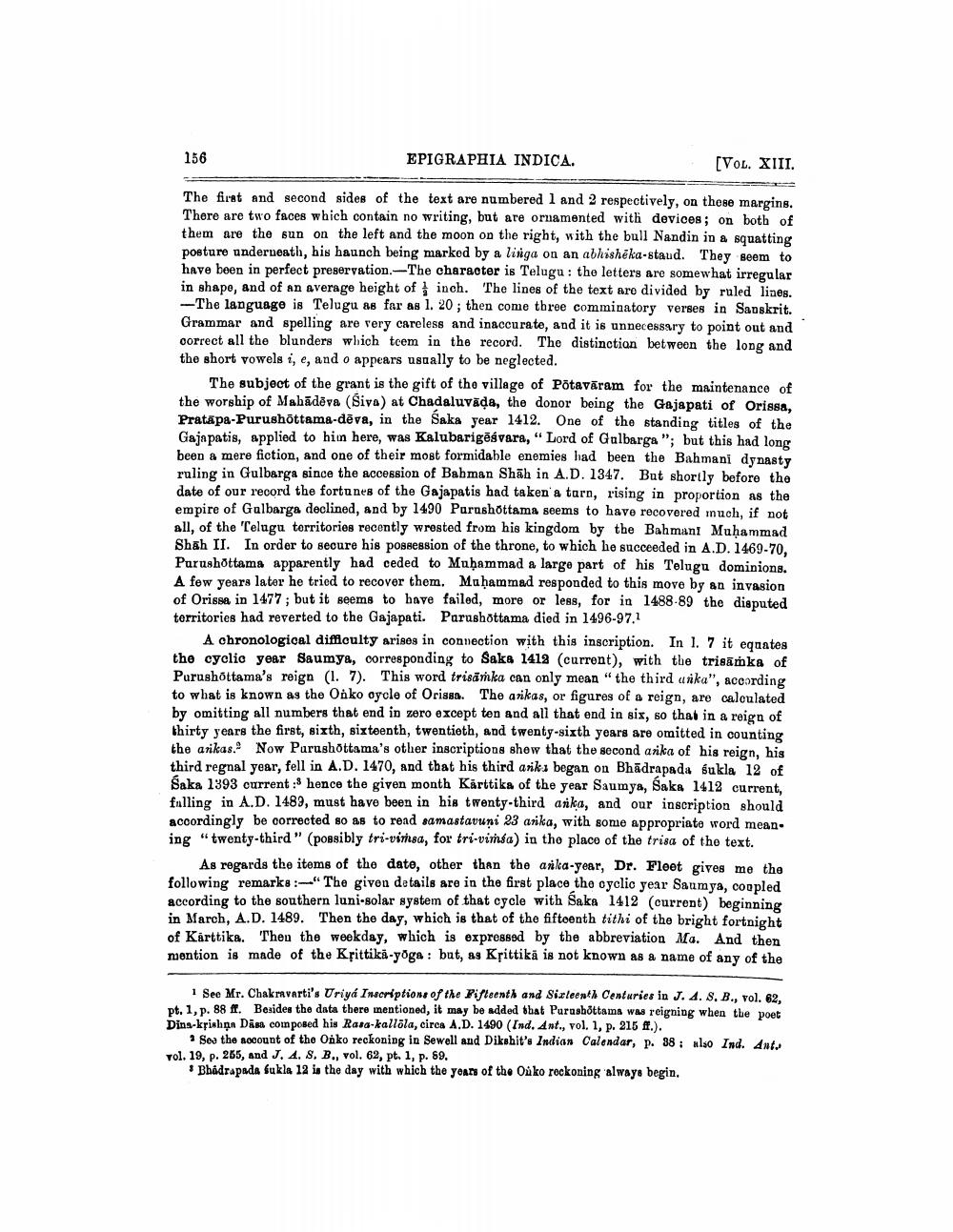________________
156
EPIGRAPHIA INDICA.
(VOL. XIII.
The first and second sides of the text are numbered 1 and 2 respectively, on those margins. There are two faces which contain no writing, but are ornamented with devices; on both of them are the sun on the left and the moon on the right, with the bull Nandin in a squatting posture underneath, his haunch being marked by a linga on an abhisheka-staud. They seem to have been in perfect preservation. The character is Telugu: the letters are somewhat irregular in shape, and of an average height of inch. The lines of the text are divided by ruled lines.
-The language is Telugu as far as 1. 20; then come three comminatory verses in Sanskrit. Grammar and spelling are very careless and inaccurate, and it is unnecessary to point out and correct all the blunders which tcem in the record. The distinction between the long and the short vowels i, e, and o appears usually to be neglected.
The subject of the grant is the gift of the village of Potavāram for the maintenance of the worship of Mahādēva (Siva) at Chadaluvāda, the donor being the Gajapati of Orissa, Pratapa-Purushottama-dēva, in the Saka year 1412. One of the standing titles of the Gajapatis, applied to him here, was Kalubarigēšvara, "Lord of Gulbarga"; but this had long been a mere fiction, and one of their most formidable enemies had been the Bahmani dynasty ruling in Gulbarga since the accession of Bahman Shāh in A.D. 1347. But shortly before the date of our record the fortunes of the Gajapatis had taken a turn, rising in proportion as the empire of Galbarga declined, and by 1490 Parnshottama seems to have recovered much, if not all, of the 'Telugu territories recently wrested from his kingdom by the Bahman Muhammad Shah II. In order to secure his possession of the throne, to which he succeeded in A.D. 1469-70. Purushottama apparently had ceded to Muhammad a large part of his Telugu dominions. A few years later he tried to recover them. Muhammad responded to this move by an invasion of Oriss in 1477, but it seems to bave failed, more or less, for in 1488-89 the disputed territories had reverted to the Gajapati. Parushottama diod in 1496-97.1
A chronological diffioulty arises in connection with this inscription. In 1. 7 it equates the cyclic year Saumya, corresponding to Saka 1412 (current), with the trisāmka of Purushottama's reign (1. 7). This word trisāṁka can only mean " the third unika", according to what is known as the Onko oycle of Orissa. The arikas, or figures of a reign, are calculated by omitting all numbers that end in zero except ten and all that end in six, so that in a reign of thirty years the first, sixth, sixteenth, twentieth, and twenty-sixth years are omitted in counting the arikas. Now Parushottama's other inscriptions show that the second arika of his reign, his third regnal year, fell in A.D. 1470, and that his third arik, began on Bhādrapada sukla 12 of Saka 1993 current :' hence the given month Kärttika of the year Saumya, Saka 1412 current, falling in A.D. 1489, must have been in his twenty-third anka, and our inscription should accordingly be corrected so as to read samastavuni 23 arika, with sone appropriate word mean. ing "twenty-third" (possibly tri-vitsa, for tri-vimsa) in the place of the trisa of the text.
As regards the items of the date, other than the arka-year, Dr. Fleet gives me the following remarks :-"The given details are in the first place the cyclic year Saumya, coupled according to the southern luni-solar system of that cycle with Saka 1412 (current) beginning in March, A.D. 1489. Then the day, which is that of the fiftoenth tithi of the bright fortnight of Karttika. Then the weekday, which is expressed by the abbreviation Ma. And then mention is made of the Krittika-yoga: but, a9 Ksittikä is not known as a name of any of the
1 See Mr. Chakravarti's Uriya Inscriptions of the Fifteenth and Sizlenil Centuries in J. 4. 8, B., vol. 62, pt. 1. p. 88 . Besides the data there inentioned, it may be added that Purushottama was reigning when the poet Dins-krishn Dasa composed his Rasa-kallöla, circa A.D. 1490 (Ind. Ant., vol. 1, p. 215 f.).
1 Se the account of the Onko reckoning in Sewell and Dikshit's Indian Calendar, P. 38 : also Ind. Asta vol. 19, p. 265, and J. 4. S. B., vol. 62, pt. 1, p. 89.
Bhadrapada Sukla 12 is the day with which the years of the Onko reckoning always begin.




